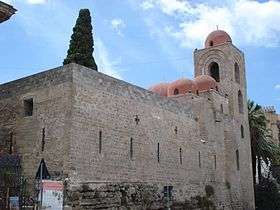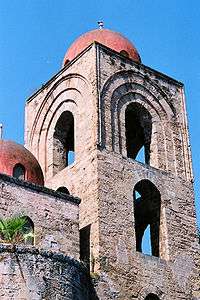San Giovanni degli Eremiti
| Church of Saint John of the Hermits | |
|---|---|
| Chiesa di San Giovanni degli Eremiti (Italian) | |
|
Exterior of the Church | |
| Basic information | |
| Location | Palermo, Italy |
| Geographic coordinates | 38°06′35″N 13°21′17″E / 38.10972°N 13.35472°ECoordinates: 38°06′35″N 13°21′17″E / 38.10972°N 13.35472°E |
| Affiliation | Roman Catholic |
| Rite | Roman Rite |
| Province | Archdiocese of Palermo |
| Architectural description | |
| Architectural style | Arab-Norman, Romanesque |
| Groundbreaking | 6th century |
| Completed | 1136 |


San Giovanni degli Eremiti (St. John of the Hermits) is a church in Palermo, Sicily, near the Palazzo dei Normanni.
History
The church's origins date to the 6th century. Later, after the Islamic conquest of Sicily, it was converted into a mosque. After the establishment of the Norman domination of southern Italy, it was returned to the Christians by Roger II of Sicily who, around 1136, entrusted it to the Benedictine monks of Saint William of Vercelli.[1]
The church was extensively modified during the following centuries. A restoration held around 1880 attempted to restore its original medieval appearance.
Architecture
The church is notable for its brilliant red domes, which show clearly the persistence of Arab influences in Sicily at the time of its reconstruction in the 12th century, the Arab-Norman culture. In her 1882 Diary of an Idle Woman in Sicily, Frances Elliot described it as "... totally oriental... it would fit well in Baghdad or Damascus".[2] However, the red colour of the domes are not original, as they were restored in the present way at the end of the nineteenth century by an architect who found pieces of red plaster on the domes and therefore decided to paint all the domes in red.
The church lies with a flank on a square construction, which was probably a former mosque. The church is on the Latin Cross plan with a nave and two aisles and three apses. Each of the square spans is surmounted by a dome. The presbytery, ending with a niche, has also a dome.
The cloister, enriched by a luxurious garden, is the best preserved part of the ancient monastery. It has notable small double columns with capitals decorated by vegetable motifs, which support ogival arches. It also includes an Arab cistern.
See also
- Arab-Norman Palermo and the Cathedral Churches of Cefalù and Monreale
- History of Medieval Arabic and Western European domes
References
- ↑ "San Giovanni degli Eremiti, Palermo". Sacred Destinations. Retrieved 21 March 2016.
- ↑ Elliot, Frances (1882). Diary of an Idle Woman in Sicily. Leipzig: Bernhard Tauchnitz.
_(7018988607).jpg)